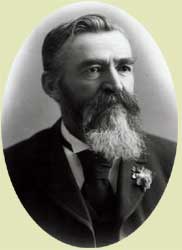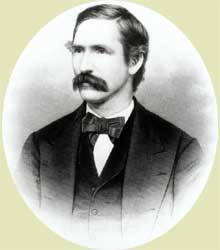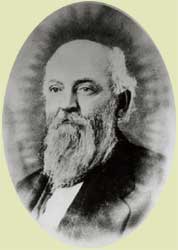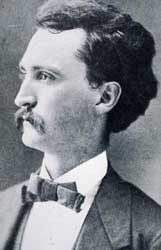|
Many
of the Bridger Trail pioneer travelers kept dairies, journals, or
wrote reminiscences after they arrived in their new home. Several
accounts have been located that provided a first hand description
of travel along the trail. They include Charles Baker, William Haskell,
Howard Stanfield, William Atchison, Cornelius Hedges, Robert Vaughn,
Frank Kirkaldie, James Roberts, William Alderson, L.B. Stateler,
Albert Brubaker, Ethel Maynard, Thomas LeForge, and Jonathon Blanchard.
The diaries were important resources that helped to determine the
route of the Bridger Trail in many locations in Wyoming.
Those Bridger Trail pioneers who
settled in the new territory contributed to the initial population
and its organization. William Alderson and his brother John remained
in the region to try their hand at agriculture. They were among
the founding members of the town of Bozeman, especially William,
who was a leading citizen in the young  community.
He was the secretary at the meeting to create the town, offered
motions for by-laws and recorded the minutes of the
meeting. He contributed in numerous ways to the new territory
and the town of Bozeman. In 1865 he was one of the first in the
community to teach school; he was instrumental in organizing religious
meetings which led to the establishment of a Methodist Church
in Bozeman in 1867; he actively helped with the expansion of the
Methodist Church on the Crow reservation; he helped to promote
agriculture among the Sioux on the Wolf Creek sub-agency; and,
as an editor, he was a founding member and officer of the Montana
Press Association. community.
He was the secretary at the meeting to create the town, offered
motions for by-laws and recorded the minutes of the
meeting. He contributed in numerous ways to the new territory
and the town of Bozeman. In 1865 he was one of the first in the
community to teach school; he was instrumental in organizing religious
meetings which led to the establishment of a Methodist Church
in Bozeman in 1867; he actively helped with the expansion of the
Methodist Church on the Crow reservation; he helped to promote
agriculture among the Sioux on the Wolf Creek sub-agency; and,
as an editor, he was a founding member and officer of the Montana
Press Association.
Cornelius Hedges cast a long and
distinguished shadow over his new Montana home. Prior to his departure on the Bridger Trail, he had been educated
at Yale and then Harvard where he took his law degree. He made
his home in Helena where he practiced law and forged one of the
most distinguished careers in the early decades of Montana politics
and education. Among his myriad contributions, he was a member
of the constitutional convention, served two terms as Montana
State Senator, was a member of the State Legislative Assembly,
served as Superintendent of Public Instruction for several years,
and campaigned as a Republican candidate for Congress in 1874.
Prior to his departure on the Bridger Trail, he had been educated
at Yale and then Harvard where he took his law degree. He made
his home in Helena where he practiced law and forged one of the
most distinguished careers in the early decades of Montana politics
and education. Among his myriad contributions, he was a member
of the constitutional convention, served two terms as Montana
State Senator, was a member of the State Legislative Assembly,
served as Superintendent of Public Instruction for several years,
and campaigned as a Republican candidate for Congress in 1874.

Major John Owen was a veteran trader
and Indian Agent returning to Fort Owen in
the Bitterroot Valley. He was in the last train (10th) of the
season. Bridger guided this train as well as the first train of
the season. The loss of 16 oxen near the Shoshone River delayed
Owen's progress so late in the year that he wintered in Bozeman
before returning to the Bitterroot Valley.
Other Bridger Trail emigrants who
successfully settled in the region included O'Dillon B. Whitford
who prospered as a physician & surgeon in Butte, Montana,
during the halcyon days of Butte's copper industry, and was elected
Mayor in 1882. William Haskell became a guide. Joseph Stafford
and B. F. Bisel became farmers, while Abram Morgan and Samuel
Anderson entered the mining profession. Amede Bessette was an
interpreter and Ethel Maynard became a stockman and rancher in
the Madison Valley near Ennis, Montana. Robert Vaughn became a
stockman, Hugh Duncan and L.B. Stateler were ministers, and Wallace
and Martha Millegan settled on a farm.
| O'Dillon B. Whitford,
M.D. |
Amede Bessette |
Robert Vaughn |
| Hugh Duncan |
Wallace Millegan |
Martha Millegan |
Of the multitudes who ventured west
in 1864, many emigrants, like Charles Baker, Howard Stanfield,
William Haskell, and William Atchison, returned to their origins
in the East after satisfying their curiosity about the western
regions, or after being discouraged by their lack of success in
the gold fields. Because this was a common occurrence during the
mining boom, the identities of many emigrants are lost to obscurity.
Howard Stanfield went west partly
as a prerequisite for achieving manhood and partly in the hopes
that the western climate might improve his health. He was just
seventeen and from a wealthy family in South Bend Indiana. Unlike
his brother, he suffered from poor health and was unfit for military
service during the Civil War. Therefore, although the trip west
was a strenuous endeavor, his father (a Judge) permitted it. Stanfield
arrived at Virginia City on July 10, and observed the
vibrant but raucous activity prevalent in the nascent gold mining
community. He and his traveling companion, friend, and neighbor
William Bartlett, soon after booked passage on a stage to Salt
Lake City. "[H]aving seen all of that town a dozen times
over . . . I sailed out of that port which I hope never to see
again. . . ." From there they proceeded to California where
Bartlett remained. However, Stanfield continued on, sailing to
New York via Panama and then rode comfortably by train east to
his home where he later prospered: first as a merchant, then in
the lumber business.
strenuous endeavor, his father (a Judge) permitted it. Stanfield
arrived at Virginia City on July 10, and observed the
vibrant but raucous activity prevalent in the nascent gold mining
community. He and his traveling companion, friend, and neighbor
William Bartlett, soon after booked passage on a stage to Salt
Lake City. "[H]aving seen all of that town a dozen times
over . . . I sailed out of that port which I hope never to see
again. . . ." From there they proceeded to California where
Bartlett remained. However, Stanfield continued on, sailing to
New York via Panama and then rode comfortably by train east to
his home where he later prospered: first as a merchant, then in
the lumber business.
Both Baker and Atchison had been
teachers in small towns in Illinois. Baker arrived in Virginia
City on July 28. The previous day, he had staked the first claim
at Washington Gulch. By August 7, he had "bought claim &
traded [his] mules," and three days later, he was "At
work for Prof. [Reverand] Blanchard shoveling Pay dirt for $5.00
per day." Baker spent the years 1865 and 1866 in the gold
mining region before returning home to Polo, Illinois, after which
he married Lydia Windle, whom he had courted prior to his departure
and written to repeatedly during the 98 day trip from Illinois
to Montana Territory.

Atchison traveled with Baker and
arrived on July 27. However, discouraged and longing for his home
in a warmer climate, he departed Virginia City exactly two months
later on September 27. He and approximately 45 others constructed
boats on the Yellowstone near Livingston, and by October 10, floated
and "sailed" downstream to the Missouri and beyond,
escaping the winter freezeup. He returned to his home in Illinois
on November 30. Atchison became a wheat buyer in Des Moines Iowa,
and later, a successful banker in the small town of Conway Springs
near Wichita, Kansas.
|
 |